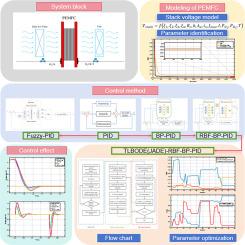Optimization of modeling and temperature control of air-cooled PEMFC based on TLBO-DE
IF 9.6
Q1 COMPUTER SCIENCE, ARTIFICIAL INTELLIGENCE
引用次数: 0
Abstract
The temperature control of the air-cooled proton exchange membrane fuel cell (PEMFC) is important for effective and safe operation. To develop a practical and precise controller, this study combines the Radial Basis Function (RBF) neural network with Back Propagation neural network adaptive Proportion Integration Differentiation (BP-PID), and then a metaheuristic algorithm is used to optimize the parameters of RBF-BP-PID for further improvement in temperature control. First, an air-cooled PEMFC system model is established. To match the simulation data with the experimental data, Teaching Learning Based Optimization–Differential Evolution (TLBO-DE) is proposed to identify the unknown parameters, and the maximum relative error is <3.5 %. Second, RBF neural network is introduced to identify the stack temperature and provide the accurate for BP-PID, which solves the problem of using sign function sgn() to approximate the in BP-PID. Regarding the temperature control of air-cooled PEMFC, several controllers are compared, including PID, Fuzzy-PID, BP-PID and RBF-BP-PID. The proposed RBF-BP-PID achieves the best control effect, which reduces the integrated time and absolute error (ITAE) by 3.4 % and 15.8 % based on BP-PID in the startup and steady phases, respectively. Since the provided by RBF changes softly and continuously during the control process, the parameters self-tuning ability of RBF-BP-PID is better than BP-PID. Third, to improve the control effect of RBF-BP-PID further, TLBO-DE is adopted to optimize the parameters of RBF neural network and BP neural network.

基于 TLBO-DE 的风冷 PEMFC 建模和温度控制优化
空气冷却质子交换膜燃料电池(PEMFC)的温度控制对于有效和安全运行非常重要。为了开发实用且精确的控制器,本研究将径向基函数(RBF)神经网络与反向传播神经网络自适应比例积分微分(BP-PID)相结合,然后使用元启发式算法优化 RBF-BP-PID 的参数,以进一步改善温度控制。首先,建立了风冷 PEMFC 系统模型。为使仿真数据与实验数据相匹配,提出了基于教学的优化-差分进化算法(TLBO-DE)来识别未知参数,其最大相对误差为 <3.5%。其次,引入 RBF 神经网络识别烟囱温度,为 BP-PID 提供精确的∂y(k)∂u(k),解决了 BP-PID 中使用符号函数 sgn(∂y(k)∂u(k)) 近似∂y(k)∂u(k)的问题。关于风冷 PEMFC 的温度控制,比较了几种控制器,包括 PID、Fuzzy-PID、BP-PID 和 RBF-BP-PID。所提出的 RBF-BP-PID 控制效果最好,在启动和稳定阶段,它比 BP-PID 分别减少了 3.4 % 和 15.8 % 的综合时间和绝对误差(ITAE)。由于 RBF 提供的∂y(k)∂u(k)在控制过程中变化柔和且连续,因此 RBF-BP-PID 的参数自整定能力优于 BP-PID。第三,为进一步提高 RBF-BP-PID 的控制效果,采用 TLBO-DE 对 RBF 神经网络和 BP 神经网络的参数进行优化。
本文章由计算机程序翻译,如有差异,请以英文原文为准。
求助全文
约1分钟内获得全文
求助全文
来源期刊

Energy and AI
Engineering-Engineering (miscellaneous)
CiteScore
16.50
自引率
0.00%
发文量
64
审稿时长
56 days
 求助内容:
求助内容: 应助结果提醒方式:
应助结果提醒方式:


